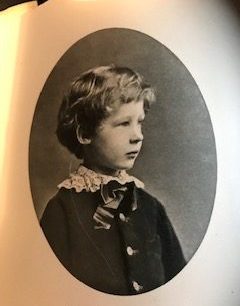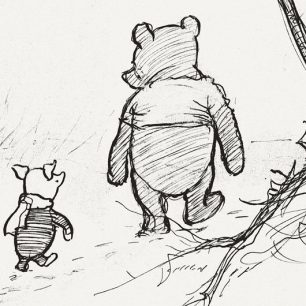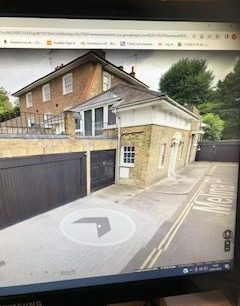E. H. Shepard OBE MC (1879 – 1976)
Childhood
Ernest Howard Shepard was born at 55 Springfield Road St John’s Wood in 1876, the third child and second son of architect Henry Shepard and his wife, artist’s daughter Jessie Lee. They had previously lived in Boscobel Place (long since demolished). When he was four they moved to 10 Kent Terrace, and their life there is described in Shepard’s Drawn from Memory, which was published in 1957.
No10 stands in the middle of the row and is ornamented with stucco columns in front and a small balcony to each drawing room window. At the top of the Terrace was a high wall, behind which were the grounds of Hanover House. There are large blacks of flats there now, where once were pleasant gardens. It was by the high wall that there sat, day in and day out, the old messenger man. He sat on a box with his back against the wall so that he commanded a view of the whole Terrace. beside him in a canvas bag was his lunch. He appeared to spend his time sleeping but he would spring to life if any householder appeared at a front door to wave or call to him. His mission in life was to run errands, though he had never been known to break out of a walk.
Ernest and his sister Ethel and brother Cyril had some happy years there but his mother became seriously ill and died, and as he said, it was years before the cloud seemed to lift. Known as Kipper at school, Shepard studied at St Pauls’, then the Heatherley art school and won the Landseer scholarship at the Royal Academy School.
Marriage and the War
n 1904 he married Florence and had two children, Graham and Mary. By 1906 Shepard had become a successful illustrator, , contributing to Punch magazine, and was a prolific painter, showing in a number of exhibitions, including sixteen times at the Royal Academy. When World War 1 broke out Shepard was in his mid-thirties but joined the Royal Garrison Artillery. He fought at the Battle of the Somme and then in autumn 1916, started working for the Intelligence Department, sketching the combat area within the view of his battery position and later fought at Arras. He was awarded the Military Cross and his citation read: For conspicuous gallantry and devotion to duty. As forward Observation Officer he continued to observe and send back valuable information, in spite of heavy shell and machine gun fire. His courage and coolness were conspicuous.
1921
Having contributed to Punch in the war, from 1921- 1953 he worked full time there. A full time position at Punch was Shepard’s dream since it not only offered a regular income, but would also allow him to sit where the revered Sir John Tenniel had once been, and work for the landmark publication that his wife’s grandfather, Ebenezer Landells had founded. Shepard had been so excited that he recalled “I nearly fell off my perch when I got the letter.” that was where he met A A Milne and first illustrated Milnes’ When we were very young poems in 1921 which led to Milne asking him to illustrate Winnie-the-Pooh. Pooh bear was modelled on the teddy bear of Ernest’s son Graham, who was called Growler. Shepard also met Kenneth Grahame at Punch, which led to him illustrating the Wind in the Willows .
After the death of his wife he moved to live with his son at 5 Melina Place in St John’s Wood but Graham was killed in action on H M S Polyanthus in the North Atlantic after a submarine attack. In 1944 Shepard remarried, to Norah Carroll, and they lived in Lodsworth in Sussex until Shepard’s death in 1976. His daughter Mary was an artist who created the illustrations for Mary Poppins.
Shepard’s original 1926 illustrated map of the Hundred Acre Wood, which features in the opening pages of Winnie-the-Pooh, sold for £430,000 at Sotheby’s in London in 2018, setting a world record for book illustrations.










No Comments
Add a comment about this page